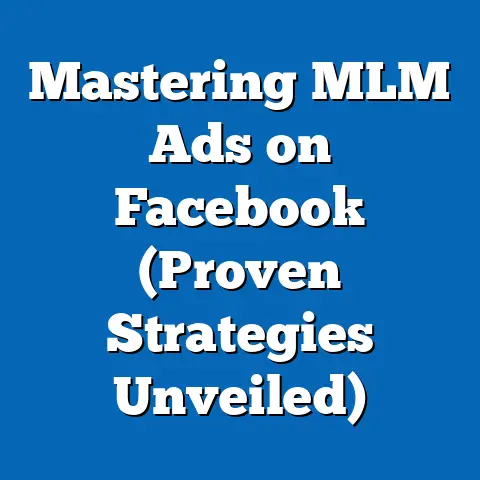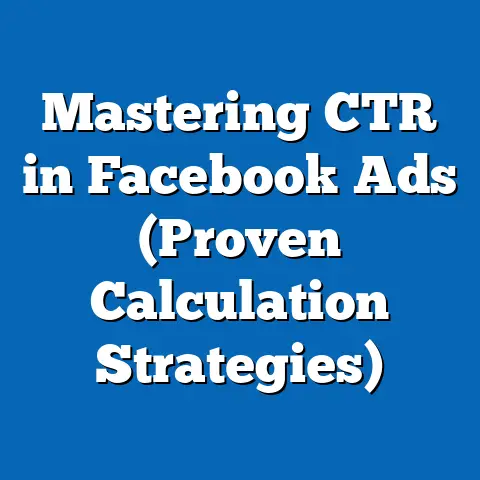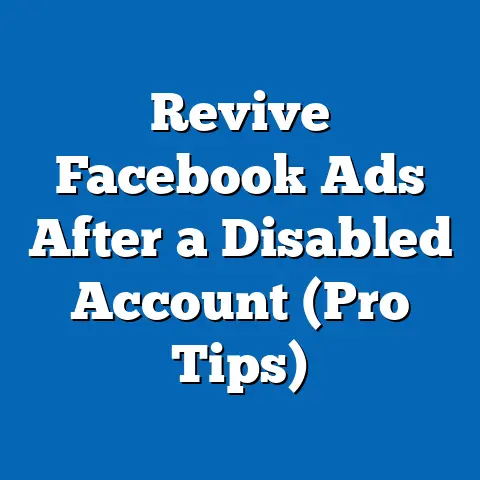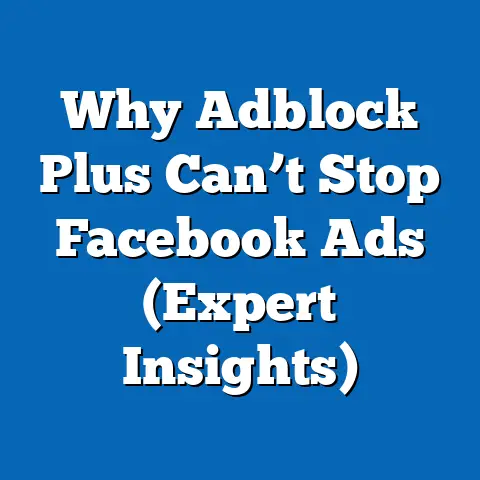Optimizing Facebook Ads for Under 18s (Expert Strategies)
Advertising has come a long way since the days of Mad Men and television commercials. I remember watching shows as a kid and being bombarded with ads for sugary cereals and the latest toys. Fast forward to today, and the landscape has completely transformed. The shift from traditional media like television and print to digital platforms has been seismic, and nowhere is this more evident than in the rise of social media. Facebook, launched in 2004, has been at the forefront of this revolution, reshaping how we connect, communicate, and, yes, how brands advertise. Over the years, marketers have increasingly focused on capturing the attention of younger audiences, especially those under 18, who are now digital natives, growing up in a world saturated with screens and social feeds. This article dives into the expert strategies I’ve used to successfully optimize Facebook Ads for this unique and important demographic.
Understanding the Under 18 Demographic
The under-18 demographic is a fascinating group, and understanding their online behavior is key to any successful Facebook advertising campaign. They’re not just “kids on the internet”; they’re a dynamic, influential force shaping trends and driving purchasing decisions.
Online Behavior, Preferences, and Interests
This demographic is characterized by their constant connectivity and fluency in digital communication. They’ve grown up with smartphones in their hands, and platforms like TikTok, Instagram, and, yes, even Facebook (though its usage varies by age within this group) are their primary sources of information, entertainment, and social interaction. I’ve noticed that they are often more adept at navigating the digital world than older generations, quickly adopting new technologies and trends.
Their preferences are diverse and constantly evolving, influenced by everything from viral challenges to celebrity endorsements. They value authenticity, creativity, and social responsibility. They’re drawn to content that’s visually appealing, interactive, and speaks to their values. Think short-form video, user-generated content, and brands that take a stand on social issues.
Significance in Social Media Advertising
The significance of this age group in social media advertising cannot be overstated. While they may not always be the direct purchasers of products, their influence on household spending is enormous. They’re the ones telling their parents what’s cool, what’s trending, and what brands to support. Their purchasing power, both direct and indirect, makes them a highly desirable target audience for many businesses.
Furthermore, they’re early adopters. They’re the first to try new products, embrace new technologies, and spread the word to their peers. This makes them invaluable for brands looking to build awareness, generate buzz, and establish long-term customer loyalty.
Psychological Aspects: Values, Social Dynamics, and Peer Influence
Understanding the psychological aspects of this demographic is critical for crafting effective ad campaigns. They are in a formative stage of life, developing their identities and defining their values. They’re highly influenced by their peers, and social validation plays a significant role in their decision-making process.
They value authenticity and transparency. They can spot a fake or insincere message from a mile away. They want brands that are real, relatable, and genuine. They’re also increasingly aware of social issues and expect brands to be responsible and ethical.
Social dynamics are also key. They’re constantly seeking connection and belonging. They want to be part of a community, and they’re drawn to brands that foster a sense of community and shared values. Peer influence is paramount, and they’re more likely to trust recommendations from their friends and influencers than traditional advertising.
Takeaway: The under-18 demographic is a powerful force in the digital world. Understanding their online behavior, preferences, and psychological makeup is essential for crafting effective Facebook ad campaigns.
Crafting Tailored Content for Younger Audiences
Now that we understand the under-18 demographic, let’s dive into how to create content that actually resonates with them. It’s not enough to simply slap a logo on an ad and hope for the best. You need to speak their language, understand their values, and deliver content that’s genuinely engaging.
Strategies for Engaging Content
- Be Authentic: As I mentioned earlier, authenticity is key. Don’t try to be something you’re not. Be genuine, be transparent, and let your brand’s personality shine through.
- Be Relatable: Speak to their experiences, their challenges, and their aspirations. Show them that you understand their world and that you’re there to help them.
- Be Humorous: Humor can be a powerful tool for connecting with younger audiences. But be careful – what you think is funny might not land well with them. Make sure your humor is appropriate, relatable, and not offensive. I’ve found that self-deprecating humor can be particularly effective.
- Be Visual: This generation is highly visual. Use high-quality images and videos that capture their attention and tell your story in a compelling way.
- Be Interactive: Encourage engagement with your content. Ask questions, run polls, and create contests. Make them feel like they’re part of the conversation.
- Be Mobile-First: They are glued to their smartphones. Make sure your content is optimized for mobile viewing. Use vertical video, short captions, and clear calls to action.
Examples of Successful Ad Campaigns
One example that always comes to mind is the “Aerie Real” campaign by American Eagle. They stopped retouching their models and showcased real women of all shapes and sizes. This resonated deeply with younger audiences who were tired of seeing unrealistic beauty standards in advertising. The campaign was a huge success, driving sales and building brand loyalty.
Another great example is the “Old Spice” campaign featuring Isaiah Mustafa. The ads were hilarious, over-the-top, and perfectly targeted to a younger, male audience. They went viral, generating massive buzz and transforming Old Spice’s brand image.
I’ve also seen success with brands that partner with influencers who are popular with the under-18 demographic. These influencers can create authentic, engaging content that promotes your brand in a way that feels natural and organic.
The Role of Visual Content
Visual content is king (or queen) when it comes to capturing the attention of younger audiences. They’re scrolling through their feeds at lightning speed, so you need to grab their attention in a matter of seconds.
- Images: Use high-quality images that are visually appealing and relevant to your message. Avoid stock photos that look generic and staged.
- Videos: Short-form video is particularly effective. TikTok has proven that. Create videos that are engaging, entertaining, and informative. Use music, text overlays, and visual effects to keep viewers hooked.
- Graphics: Use graphics to convey information in a visually appealing way. Infographics, charts, and diagrams can be a great way to share data and statistics.
Takeaway: Crafting tailored content for younger audiences requires understanding their values, speaking their language, and delivering content that’s authentic, relatable, and visually appealing.
Leveraging Facebook’s Targeting Features
Facebook’s ad targeting options are incredibly powerful, allowing you to reach specific segments of the under-18 demographic with laser precision. However, it’s crucial to use these features responsibly and ethically, keeping in mind the unique vulnerabilities of this age group.
Demographic Targeting
Facebook allows you to target users based on their age, gender, location, and language. This is a basic but essential starting point for targeting the under-18 demographic. However, it’s important to note that Facebook has restrictions on targeting users under 18 with certain types of ads, such as those promoting alcohol, tobacco, or gambling.
Interest-Based Targeting
This is where things get interesting. Facebook tracks users’ interests based on their activity on the platform, including the pages they like, the groups they join, and the content they interact with. This allows you to target users who are interested in specific topics, hobbies, and brands.
For example, if you’re selling skateboarding equipment, you can target users who are interested in skateboarding, skateboarding brands, or skateboarding influencers. Or, if you’re promoting a new video game, you can target users who are interested in gaming, specific game genres, or gaming streamers.
Behavioral Targeting
Facebook also tracks users’ behaviors, such as their purchase history, their travel habits, and their device usage. This allows you to target users based on their actions and habits.
For example, you can target users who have recently made a purchase online, users who have traveled to a specific location, or users who are using a specific type of device (e.g., iPhone).
A/B Testing
A/B testing involves creating multiple versions of your ad (e.g., different headlines, images, or calls to action) and showing them to different segments of your audience. This allows you to see which versions perform best and optimize your ads accordingly.
I always recommend A/B testing when targeting the under-18 demographic. Their preferences are constantly evolving, so it’s important to stay on top of what’s working and what’s not.
Facebook Insights
Facebook Insights provides valuable data about your audience, including their demographics, interests, and behaviors. This data can help you refine your targeting, optimize your content, and improve your overall campaign performance.
Pay close attention to the metrics that matter most, such as click-through rate (CTR), conversion rate, and cost per acquisition (CPA). Use this data to identify what’s working and what’s not, and make adjustments accordingly.
Takeaway: Facebook’s targeting features are powerful tools for reaching the under-18 demographic, but it’s crucial to use them responsibly and ethically. A/B testing and Facebook Insights can help you optimize your campaigns and improve your results.
Compliance and Ethical Considerations
Marketing to minors comes with a unique set of legal and ethical considerations. It’s crucial to be aware of these considerations and to ensure that your ads are compliant with all applicable laws and regulations.
Privacy Laws and Advertising Standards
Several laws and regulations protect the privacy of children online, including the Children’s Online Privacy Protection Act (COPPA) in the United States and the General Data Protection Regulation (GDPR) in Europe. These laws require you to obtain parental consent before collecting personal information from children under 13.
Facebook also has its own advertising standards that prohibit targeting users under 13 with certain types of ads, such as those promoting alcohol, tobacco, or gambling.
I’ve always found it best to err on the side of caution when marketing to minors. Be transparent about your data collection practices, obtain parental consent when required, and avoid targeting them with ads that are inappropriate or harmful.
Transparency and Building Trust
Transparency is essential when marketing to any audience, but it’s particularly important when marketing to minors. Be upfront about who you are, what you’re selling, and why you’re targeting them.
Build trust by being honest, authentic, and respectful. Avoid using deceptive or manipulative tactics. Focus on providing value and building a genuine connection with your audience.
Creating Effective and Responsible Ads
Creating ads that are both effective and responsible requires a delicate balance. You want to capture their attention and persuade them to take action, but you also want to do so in a way that’s ethical and responsible.
Here are a few tips:
- Focus on Value: Highlight the benefits of your product or service and how it can help them solve a problem or achieve a goal.
- Be Clear and Concise: Use simple language that’s easy to understand. Avoid jargon and technical terms.
- Be Respectful: Treat your audience with respect and avoid using language that’s offensive or condescending.
- Be Honest: Don’t make false or misleading claims about your product or service.
Takeaway: Compliance and ethical considerations are paramount when marketing to minors. Be aware of the applicable laws and regulations, be transparent and build trust, and create ads that are both effective and responsible.
Conclusion
Optimizing Facebook Ads for under 18s requires a nuanced understanding of this demographic’s online behavior, preferences, and psychological makeup. By crafting tailored content that’s authentic, relatable, and visually appealing, leveraging Facebook’s targeting features responsibly, and adhering to strict compliance and ethical considerations, brands can connect authentically with younger audiences and foster a loyal customer base for the future. Remember, it’s not just about selling a product; it’s about building a relationship and creating a positive impact on their lives. I’ve seen firsthand how powerful this approach can be, and I encourage you to embrace these strategies to unlock the potential of Facebook advertising for the under-18 demographic.





